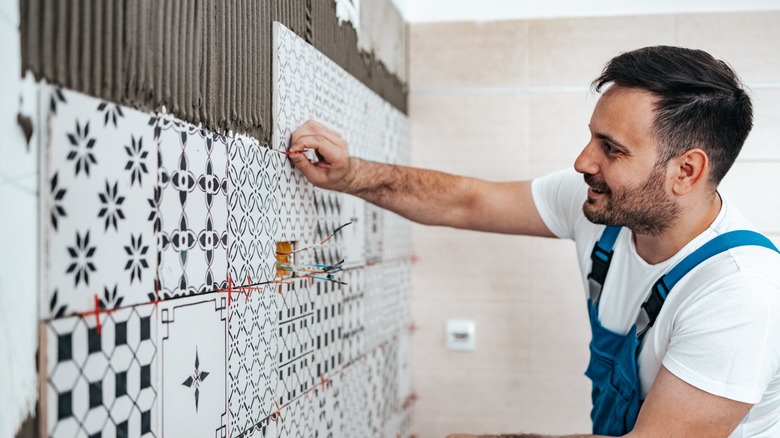Mike Holmes' Family's Advice On How To Use Thin-Set Mortar To Install Tile And Stone
Tile and stone have always been popular for walls and floors. They are both durable and attractive, with color, pattern, and texture choices for just about every taste and style of décor. They are also materials that, with patience, can be installed by the average DIY enthusiast. One key to getting the job right is understanding how to choose the correct tile adhesive. Thin-set mortar is generally what the pros use to install tile and stone, but as Mike Holmes' daughter, Sherry Holmes, advises on the Make It Right website, there's more to it than just popping down to the hardware store and grabbing the nearest bag.
Her first piece of advice is not to confuse grout with thin-set mortar. The two can look similar. However, while grout fills the gaps and gives that finished look, it is not an adhesive. Do you know how tiles adhere to the surface? Sherry explained that it's with thin-set mortar.
For those who don't know, Sherry then explained the composition of thin-set mortar. It is similar to the mortar used for building but not as thick (hence thin-set). There are actually two types: unmodified, which is made from sand, Portland cement, and water retention agents, and modified, which also includes latex or other polymers. Both are generally available in pre-mixed buckets (ideal for small jobs or repairs) or powder form that is mixed with water.
When to use unmodified or modified thin-set mortar
The key advice that Sherry Holmes provides is when to use the different types of thin-set mortar. Much of the focus is on modified thin-set mortar, which is increasingly popular because of its versatility. It is commonly used on plywood or OSB subfloors, and obviously, properly preparing your subfloor for laying tile is an important step. Sherry explained that it is also used when tiling on drywall. It shouldn't be used over a membrane, like on a bathroom floor, she said, because the moisture can't escape and it won't cure; similarly, it's not recommended for stone tile. For this type of application and for tile on concrete, you should use unmodified thin-set mortar.
Sherry talked about working with thin-set mortars from leading brand Schluter, and how following the manufacturer's instructions is vital for proper performance. This is true of any thin-set mortar. Attention to detail is always important, and not using the right adhesive or the right amount is one of a dozen common mistakes to avoid when tiling.
There are a couple of tips about thin-set mortar worth knowing that come from others within the tiling trade. When using powder, it should always be added to the water, not water to powder. Also, it's better to work with small amounts so it doesn't go off before you can use it. Finally, because thin-set contains silica, which can cause lung damage, always wear a face mask when you're mixing it.

